For many businesses, starting on Social Media can be overwhelming. After all, there are so many networks available, and all of these networks are constantly adding new features. You’ve got to learn about and integrate new features into your plans.
As a startup or small business, you don’t have a full-time team or even a person available for you to do all this work. Therefore, the success of you and your company on Social Media depends on you creating a straightforward and actionable social media strategy that fits with the people you’ve got available and with your goals.
And while social media can be a powerful marketing channel that can support your business objectives, you can’t just go around sharing links to every new blog post you publish.
Or maybe automatically retweet every piece of industry news that is available.
Your customers are humans, and as a result, they expect variety, engagement, and native content that is tailored to each social network you’re active on.
This social media strategy guide will help you create a documented strategy that can support your overall business goals, increase brand awareness, and in the end, also drive traffic to your website.
Which in return will help you grow your business, and at the end of the day, isn’t that what we all want?
Table of Contents
- #1: Identify your business objectives
- #2: Set Marketing Objectives
- #3: Identify Your Target Audience
- #4: Research Your Competition
- #5 Choose your social media networks
- #6 Fill out your social media profiles completely
- #7 Find your tone of voice
- #8 Identify your topics
- #9 Pick your posting strategy
- #10 Analyse and test
- Your Turn
#1: Identify your business objectives
Before you head off and start creating a social presence on every platform that is available at the moment, though, first take a step back.
Like everything related to your business, you can’t learn anything and move your business forward if you don’t know what you want to achieve.
Over at the Evergreen Content Poster, we’re big fans of the thinking that came forward out of the lean startup methodology.
One of the three core principles of the lean startup talks about a feedback loop, which helps you validate which business activities in the marketplace are the most practical activities. They call this the Build–Measure–Learn loop.
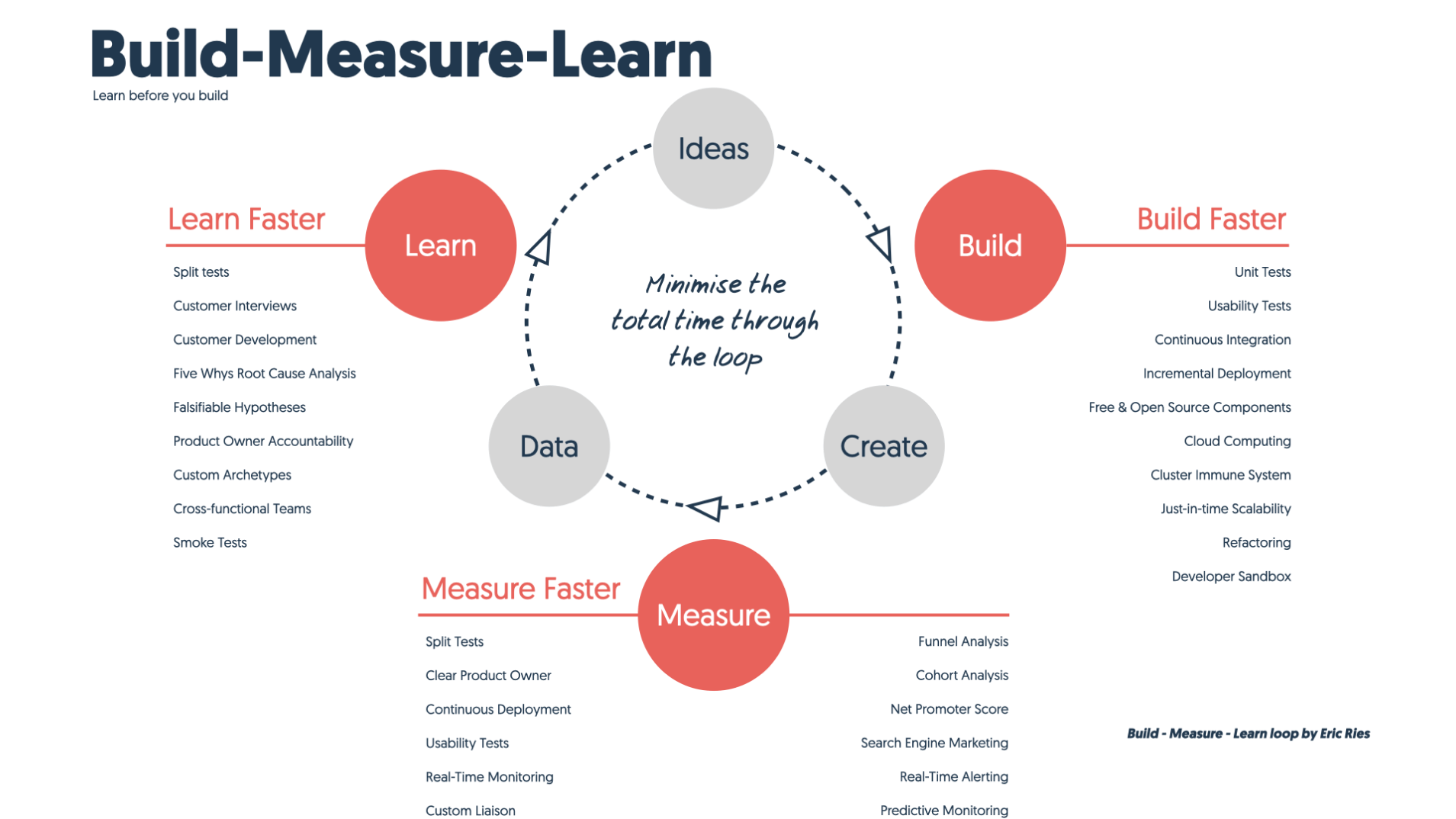
Most people will see this and will start to build it straight away. However, before you can start making anything, you first need to identify what you want to learn.
The reason for this is that learning can only happen from measurable outcomes. Starting with your social media goals in the back of your mind also makes it easier to understand how you got there or didn’t get there.
As a result, you can better analyze what worked and what didn’t work and double down on those.
To many businesses just try something once or twice without thinking it through. They then think, nope, this isn’t working for me, and move on to another social media channel. Abandoning all the hard work they had done up until then.
If you closely look at your company’s needs, how do you think social media will help achieve those goals? Why is it that your company exists? What problem are you trying to solve for your customers?
In the end, Content Marketing and Social Media Marketing are just other ways of solving your customer’s problems. Instead of using your product, you use content, but the end goal is the same.
When setting up your social media objectives and goals, go beyond the vanity metrics such as Retweets and Likes. Instead, focus on more advanced metrics such as leads generated, web referrals, and conversion rates for your business.
You can probably come up with some very personal goals for you and your company; however, next to these specific goals, there are a couple that all businesses, most of the time, include in their social media strategy:
- Increase exposure
- Increase traffic
- Increase engagement
- Collect marketplace insights
- Develop brand ambassadors
- Generate leads
- Grow business partnerships
- Improve sales
For starters, it’s good to choose two primary goals from your personalized list and two secondary goals from the general list mentioned above. Having too many goals straight from the start will create a distraction for you, and you might achieve none of them.
#2: Set Marketing Objectives
If you want your strategy to be an effective social media strategy, you then need to figure out what „success“ on social media looks like for your business.
So once you’ve identified your business objectives, it’s time to develop the related goals that will enable you to be successful. You need to define the key performance indicators (KPIs) that you will be focusing on and optimizing for.
Try setting your goals the S.M.A.R.T. way. Make them Specific, Measurable, Attainable, Relevant, and Time-Based.
The trouble with not having a goal is that you can spend your life running up and down the field and never score.
– Bill Copeland.
Specific
Now we know what we want to learn from our social media efforts, it’s time to start thinking about how we can measure to see if we’re on the right track. After all, if you’re setting goals without any specific parameters to measure if you’re achieving your goals, you will never know if you’re moving the needle in the right direction.
For example, if you set generating leads and sales as one of your objectives, how many leads or sales do you need to make via social media before calling it a success? Is it one lead per week or ten leads per week?
Measurable
Looking at our business objectives we created in the first step, let’s see how we can measure them:
- Increase exposure – Metrics: Reach, Impression, View
- Increase traffic – Metrics: Pageviews, Unique Visitors, length of visits
- Increase engagement – Metrics: Likes, Shares, Comments, Pins, +1, Retweets, Favourites
- Collect marketplace insights – Metrics: Survey Entries, Comments
- Develop brand ambassadors – Metrics: Fans, Followers, Engagement on posts
- Generate leads – Metrics: Hard lead, Soft Lead
- Grow business partnerships – Metrics: Contacts
- Improve sales – Metrics: Orders, New Customers, Sales Revenue
Attainable
If you’re setting a goal for yourself and your company that you can never achieve, that is a recipe for disaster. At one point, you will lose motivation, and you will never get there. If you’re just starting your social media marketing and set yourself an objective to increase your sales from 1 per month to 1000 per month, it’s doubtful you will meet it.
Relevant
This step ensures that the goal matters to you and your business and aligns with potential other targets you’ve got within your organization.
By making sure that the objectives are relevant to your company’s overall vision, you’re making sure that you’re spending your marketing budget wisely.
Choose objectives you can achieve, given the people and the resources you have.
Time-based
When do you want to achieve your goals? Is it next week, one month from now, at the end of the year? By adding a precise end date to your test, you make it easier to decide whether your experiments have successful or unsuccessful outcomes.
Your objective of improving your sales by 25% may be specific, measurable, attainable, and relevant. Still, if you don’t set a deadline for achieving this goal, all your efforts, resources, and attention may be pulled in different directions over time.
#3: Identify Your Target Audience
When your business is suffering from low engagement on their social profiles, it’s usually because you are creating content for people who are not your ideal target audience personas.
By setting up buyer personas for your organization, you can help to get the right tone of voice and the most relevant type of message at the right time towards your most preferred target audience.
It makes a big difference if you’re trying to create a post for someone above 50 or a millennial.
Knowing your customer’s age, work, income level, interest, pains, problems, habits, likes, dislikes, motivations, etc., etc. makes it easier and cheaper (when promoting your content) to target them on social or any other media.
The more specific you can be, the more focused you can create your content, and the more conversions you will get out of all the social media channels that you will become active on.
#4: Research Your Competition
Every start is difficult. And this is the same when starting your marketing on social media.
When building your visual brand as part of your branding essentials, you already did a competitive analysis. Not only will this give you insights into visual trends for your industry, but it can, in this case, by looking at what you’re competitors are doing on social media.
It could already give you an idea of what’s working and what’s not working, so you can integrate those ideas successfully into your efforts. And this is the same when starting your marketing on social media.
If you’ve not done so already, start by compiling a list of at least three to five of your primary competitors. Try to identify which social networks they are active on and analyze their content strategy.
Things to look into are their number of fans or followers, posting frequency and which time on which days, posting lots of visuals and what type of visuals, participating in popular hashtags like #MotivationMonday, etc., and how are their fans responding to their postings? How are they reacting to the engagement of their fans?
The most important activity you need to look into is engagement rates. Even though the actual detailed statistics are only visible to accounts admins, you can get a pretty decent picture of what is happening by doing some manual work.
Facebook makes your life even more accessible by offering the ability to watch the pages of your competitors on the insights of your page.

Although this only gives you a week’s views, it is still pretty powerful. If you want to dig deeper, go to your competitors‘ pages and social accounts.
By dividing the number of engagement activities (likes, comments, shares, retweets, favorites, etc.) by the total number of fans or followers, you can calculate how you are stacking up against them.
#5 Choose your social media networks
Picking the right social media network for your business can be a difficult task. After all, you don’t have time to spend on all of them, right? You still need to run a business too!
However, each social media network is unique, with its best practices, style, and audience.
So how do you choose which one to create a profile on? Simple. Just choose the social network that best fits your strategy and the goals you want to achieve via any social media platform.
Okay, that might have sounded a little too easy.
The number one rule to make a decision?
The number one rule to make a decision? You don’t have to be on them all—just those that matter to you and your target audience.
Diving a bit deeper, there are three things to help you consider which social network to try and also how many social networks you should try:
- Time – How much time can you spend on each social network? When you want to take the proper time to investigate a social network, build an audience and engage with your audience, you will need at least one hour per day (especially when building an audience). Are you able to spend enough time on it to make it worthwhile?
- Resources – What are your skills and the people working in your organization? Visual social networks like Instagram or Pinterest require images and photos. YouTube needs video. Podcasts require audio content, etc., etc. And don’t underestimate the power of „niche“ networks, like Google Business Profiles, to bring in more customers via local search queries. Do you have the correct people and skills in your company to create the content you need to share on these networks?
- Audience – Where do your potential and current customers hang out? Lastly, which social network attracts the right audience for your business?
Try answering these questions before deciding to create an account and start creating content!
#6 Fill out your social media profiles completely
There are already a lot of websites out there telling you what the correct size and dimensions should be for your profile picture and the headers visuals you can add to your different social profiles. However, what we would like the focus on is the content, the nitty-gritty that makes your profile stand out from your competitors.
Optimizing your social media profile pages is one of the most overlooked aspects of social media marketing.
However, for many people, a profile page is the first contact with a company, and it can make or break your social media marketing efforts.
If you’re active on social media with your business, at one point, people will see a post passing by from you that looks interesting. They will click on the profile link and end up on your profile page. You need to ensure that you’re leading them down a path of taking your desired action(s) with every part of your profile page.
Another reason for filling out your profiles completely is for Search Engine Optimization or SEO purposes. Of course, you’re already optimizing your website for search engines like Google, but at the same time, it’s important to remember that SEO extends to all of your online content.
So if you’re filling out your social profiles, it’s vital to make sure you keep this in mind and optimize your profiles.
Why?
Well, your social content ranks in search engines, just like your website. Often social media content will appear for key search terms. This means that if your content gets ranked highly, your profiles will attract more views and, hopefully engagement or traffic back to your website.
And sure, social media isn’t a direct ranking factor for your website, according to Google, but this doesn’t mean social signals won’t help with Google SEO in an indirect way.
Research done by CognitiveSEO does seem to be that the higher a website ranks in search, the more of a social media presence it has, as you can see in the below graphic:
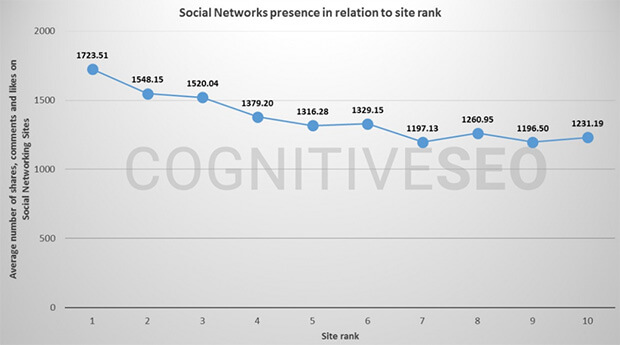
Their research of over 23 million social shares even found a definitive link between social shares and search engine ranking:
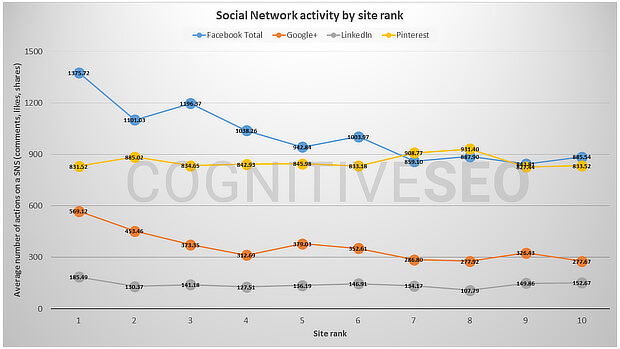
So as you can see, there’s no denying that the highest-ranking pages in Google search results usually have a lot of shares. Though this is probably due to a few related factors:
- More social shares generate more traffic to the page itself
- More shares also make your content more likely to build backlinks
Because of that, getting more social shares does help your search engine rankings, if only indirectly.
So not only should you have an account on the social networks that are relevant to your business, but you need to optimize the account profiles and in the end also make it easy to share your content and help amplify those social signals.
But let’s start by optimizing your social profiles first before sharing any content.
Your profile picture or avatar
A profile picture or avatar is a small image that you upload to your profile, and from then on, it will sit with you throughout your period on the network. It is necessary because it is the quickest way where new and existing followers will recognize you. Even though you only supply the barest, minimum amount of details when registering and creating your profile, make sure you upload an avatar.
Whether you’re building your social media profile for your company or your brand, you will go with your logo or a personal picture.
Once you’ve selected what your profile picture or avatar will be, be sure to keep it consistent across all social networks; that way, people will easily recognize you across all social networks.
Oh, and be sure to name your avatar file correctly before uploading it. If you call your profile picture something like yourname.jpg or yourbusinessname.jpg instead of IMG01234.jpg, it will help with Search Engine Optimization (SEO). It brings value to search engines, as they can now put a picture to a name.
Your cover photo
Your cover photo is THE most significant piece of real estate on your profile page. It is the first eye-catching piece anyone will notice when they visit your profile page for the first, so be sure to use it correctly. Many companies let this opportunity go to waste by posting something generic as their cover picture.
Social media is a fast-moving world; people will not spend hours watching your page. People are gone before you know it if you don’t make it enjoyable, exciting, or interesting. Think of your cover photo as the billboard standing next to the highway. People are passing by at 60 miles per hour; before you know it, they are gone, and so is their attention. Make this short attention span count!
Use this valuable real estate to its fullest with an eye-catching visual. Use an image that gives your visitors a sense of what your products or services are all about. Use text overlays next to the graphic to communicate to make it even more evident for people what you and your profile are all about.
Some great examples:
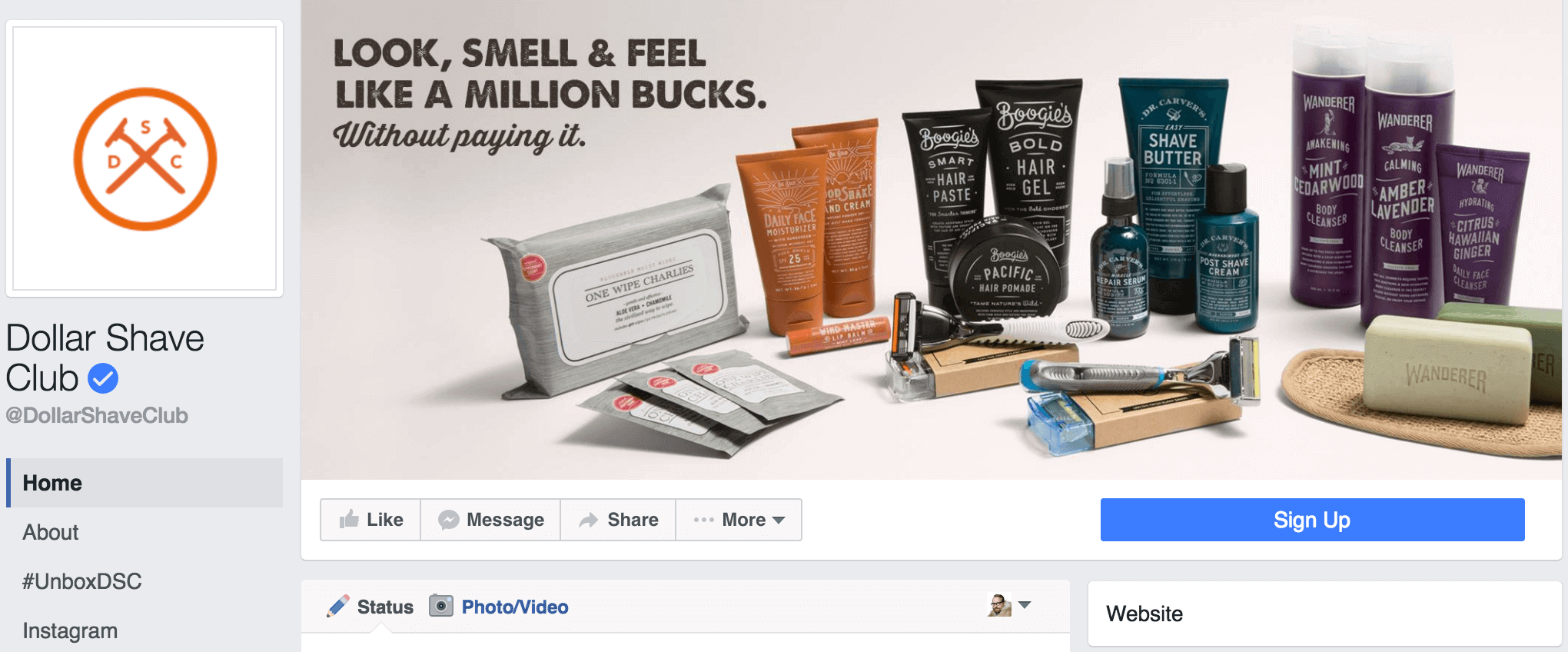
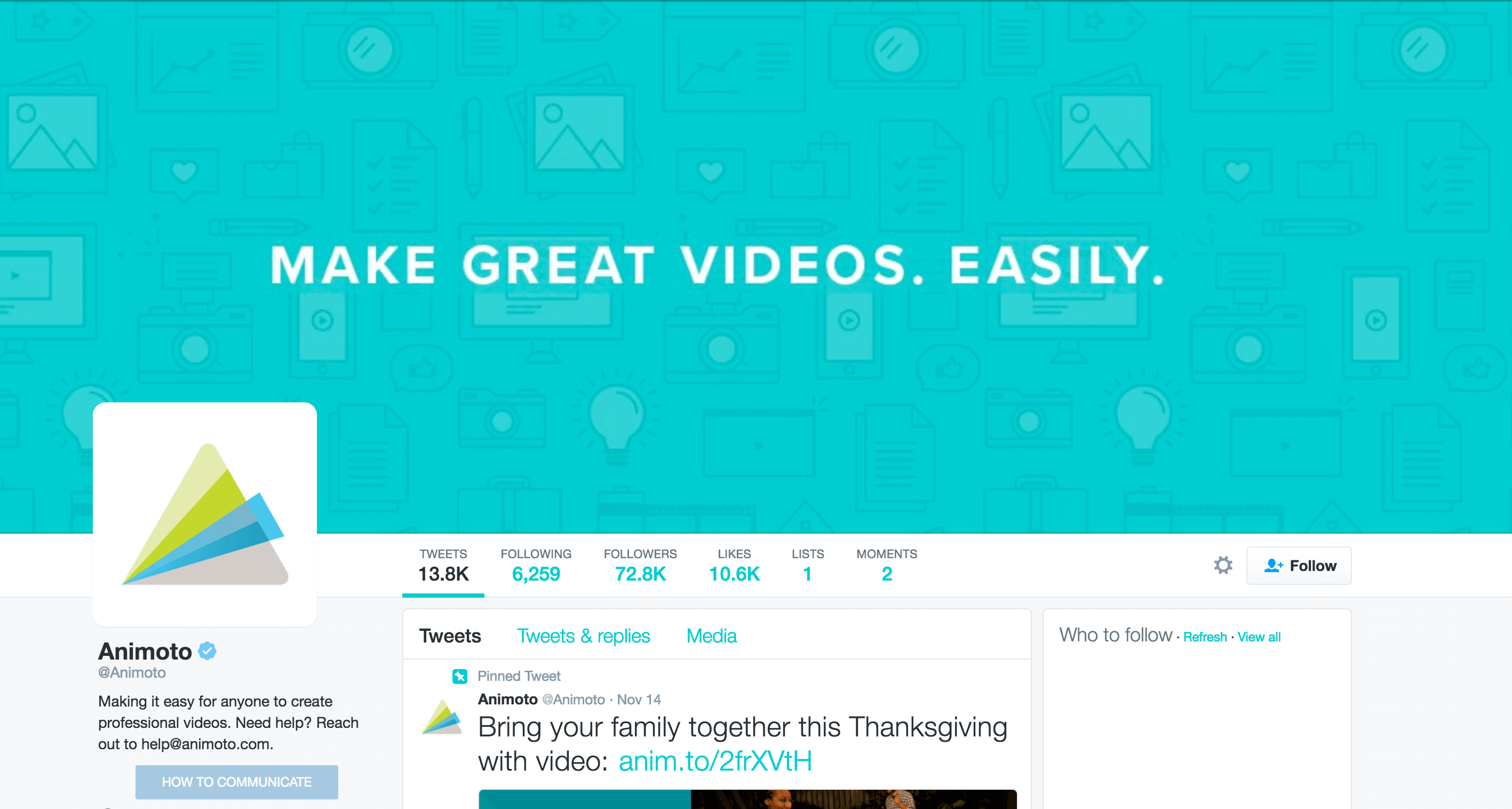
If you look at the above examples from the Dollar Shave Club on Facebook and Animoto on Twitter, they both have a good, Unique Value Proposition available on their header visual. The Dollar Shave Club is offering an excellent overview of its products, and Animoto showcases how easy it is in the background to create professional videos. Both are great examples of header visuals.
Your biography
So you got people already interested enough to stay a bit longer on your profile page and look beyond the cover photo. The next item they will look for is mostly your bio. Not only does your bio serve as an introduction to new viewers, but it is one of the steps that will determine whether or not someone will follow you or take another action, such as clicking on the link to your website.
So what does it take to create a compelling bio? A good biography will:
- Accurately explain who you are and what your company does. Think about your Unique Value Proposition. How do you set yourself apart from your competitor?
- Personify your brand. Many social networks are more lighthearted than their official company website counterparts. Don’t worry too much about writing a formal biography; this is the place to show off the fun side of your brand by maybe even including an emoji or special formatting.
- Target your ideal customers. Try using specific words that your ideal customer would use to describe themselves. Although keywords on most social networks are not directly searchable, viewers will immediately know that you are a relevant account for them to follow or like.
The most challenging part of it all? There is only a limited space for writing your bio. Twitter, for example, only allows 160 characters, and Instagram even only 150.
One other thing to remember here is that consistency can go a long way in helping people recognize your brand on different social media channels. Of course, not all networks have the same amount of available characters, so you won’t have to make them entirely identical. However, you should include enough of the exact phrases and keywords and try to use the same tone of voice so that your name and your profile will be familiar across multiple platforms.
Your pinned post
This is the fourth and final most crucial item of any profile page. The item where the magic happens. The item where you can successfully and consistently get people to take action. When people see a first interaction appearing in their newsfeed that triggered them to arrive on your profile page, they scan your profile; they are almost always checking out what kind of content you’re posting.
For example, Facebook, Twitter, and LinkedIn company pages offer the ability to pin a post or a Tweet to the top of your profile. This should be the post or Tweet that showcases who you are and what your content is all about. The money shot after you post it to pin it to the top and let it be the final way to convince people to follow you!
#7 Find your tone of voice
At this point, you might be tempted to start posting immediately. After all, you’ve created your social media account. They’ve got the correct avatars and header images, and without content, they look a bit sad, right?
However, there are two more steps needed to take before you can start to create any post on any social network. This step is about creating your tone of voice, and the next one will be about the different types of content you should be posting. Without these, your posts will not be focused enough, so hold your horses for just a little bit longer.
When you’ve identified your target audience in step 3 and even earlier in your Unique Value Proposition, you were already setting the basis for your tone of voice. To get started, though, with finding your correct tone of voice, ask yourself:
- What kind of personality would your brand have if your brand was a person?
- If your brand was a person, what’s their relationship to your ideal customer? Would it be a mentor, a friend, a family member, etc.?
- Describe using your Brand Personality Adjectives. What your company’s personality is and is not;
- Are there businesses that have the same type of personality as yours? What makes them similar?
- When they read your posts, what feeling do you want to leave with your customers?
Using the Brand Personality Adjectives list and the answers to the above questions, you should end up with a list describing your marketing tone of voice. To make it even more concrete for yourself, ask yourself the following question:
If there was no logo, or no company name next to your posts on social media. Do you sound different, unique—like yourself? Or do you sound like everyone else… including your competitors?
Or in short:
If the label fell off… would people know it was you?Click To TweetYour tone of voice isn’t about what you say but how you say it. That impression your brand leaves on your (would-be) customers or prospects.
#8 Identify your topics
Now that you’ve identified which social networks to post to, you’ve filled out your profiles for your accounts, and you’ve found your tone of voice on how you will communicate, there is only one last hurdle to overtake before starting to post: it’s time to start thinking of the types of content you’re going to post.
While with content marketing, you should develop content that aligns with your business objectives. Developing content that solves the problems your customers are facing and your product, for example, is already addressing—developing content around the common challenges faced by your target audience. We can quickly go a little bit deeper and more comprehensive on social media.
Everybody wants engagement, virality, retweets, likes, shares, and followers, but getting it is easier said than done. So the question is, what kind of social media content gets that kind of love? More importantly, what type of content gives you and your audience the most value and receives the most extensive engagement?
Here at the Evergreen Content Poster, we’ve identified ten different content types useful for each organization. You don’t need to use all, but try to get a good mix of the various topics:
- Added-value Content – Inspirational, useful information for the reader. For example, whitepapers, studies, instructional videos, tutorials, studies, expert explanations, and sector-evolution verticals…
- Stories – The human side of the organization. For example, inside information, interviews, heritage, origin raw materials, old marketing material, client stories, etc.
- Special Dates – Events. For example: launch a new product/service, events that are sponsored by your brand, special dates related to your brand (new location, …), etc.
- Promo – Special actions to drive sales. For example, coupons, limited-time deals, limited quantity deals, etc.
- Fun – Not business-related. For example, contests, top topicals, cartoons, etc.
- Company information – Messages about your company. For example, product / service-related info, contact details, infographics, upcoming products/services/news, acquisitions, case studies, etc.
- Sector information – Messages about your sector. For example, trends & predictions, infographics, future analysis, new technologies, sector news, etc.
- Participation & collaboration – Client-brand-related actions. For example, the co-creation of new services, co-creation of new packaging, challenges, fan photos, fan assignments, feedback calls, etc.
- Surprise & delight – Special surprises for the fans, feel-good actions. For example, limited giveaways, birthday wishes, viral videos, etc.
- Social awareness – Support good causes. For example, articles about a good cause, call for support, etc.
#9 Pick your posting strategy
What should you be posting? Is it just text updates, videos, static pictures, or animated gifs? How often should you be posting on your networks? Is it once every other day, or is it twice per day? And at what times should you be posting?
The answer to all of these questions is:
it depends
As explained earlier, different types of things are suitable for various organizations. What works for you does not have to work for me and visa-verse. That being said, let’s try to formulate some general answers to these questions and help you get going.
What should you be posting?
There’s no secret formula to engaging with your social media audience successfully. However, applying the 80/20 rule should always be a big part of your social media strategy. Use 20% of your content to promote your brand, and use the other 80% for content that really interests your target audience and helps them engage in conversations.
Of course, social media is an essential part of any marketing mix, but people use social media to be social. They are not on Facebook, Twitter, or any other network to be subjected continuously to your online sales pitch. Social media is about building relationships with your audience, not forcing them to watch the same message repeatedly.
However, this does not mean that you could not use your own branding on the other 80%, on the contrary. But only 20% of your content should have a Call-T0-Action:
20% OF YOUR BRAND'S CONTENT: INCLUDE PERSUASIVE CALL-TO-ACTIONSClick To TweetWhen creating content that is first in the 20% part of your content, you need to include information that benefits your readers, include a discount, a special offer, provide valuable statistics, etc. Make sure you integrate a persuasive Call-To-Action that inspires your audience to learn more about your company and your offering. Call-To-Actions that possibly lead to conversions in the future.
80% OF OTHER 'INTERESTING CONTENT': MAKE IT SHAREABLEClick To TweetFor the other 80%, you want to share compelling content from influencers whose ideas and insights you agree with. You could easily think about retweets, sharing inspirational quotes, links to industry news, questions, etc. It supports your thinking, the way you take care of your business, or items about your industry that is in line with the content you’re creating.
How often should you be posting?
The frequency of how often you should be posting depends on many different factors. However, for us, the most important one is resources. It’s no good to post seven times or more per week on your various social channels when it creates so much work that you can’t take care of the rest of your business anymore. Creating content is not something done quickly; you want good quality content to help it stand out from the rest.
Of course, excellent companies are researching how often you should be posting. But it’s all dependable on what is sustainable for you and your organization. It’s always better to slowly move up to posting more often than having a „burnout“ and not posting for weeks at a time because it is not sustainable.
However, if you do get the time, just remember: If people love your updates, you can typically always get away with posting more.
When should you be posting?
This one is easy. The best times to post on social media are when the people you want to see the content are on the network.
Each social network has its own set of times on which users are more active. These times roughly seem to be the same throughout the globe, like checking in on Facebook is between 1–4 p.m. late into the week and on weekends. Coschedule has an overview of 16 studies done on the matter, don’t forget to factor in these times to the time zones in which your target audience is active, though!
#10 Analyse and test
Every brand is different, every business is different, and all social networks are different. What is working for one company on one network does not have to work for your business on that same network.
If you look at your statistics, you will probably notice that same thing.
However, the more you post, the more you will discover which type of content, which timing, and which frequency works best for you and your business.
If you can’t invest in a paid all-in-one social media dashboard, remember that most prominent social networks have basic analytics built into their platform.
Remember that Build-Measure-Learn loop from the beginning of this article? You will use that same loop to analyze and track your progress.
But before you start, first set yourself a benchmark. Look at your postings from the last couple of weeks or months. Try to identify the average number of clicks, shares, likes, retweets, comments, or any other form of engagement your posts are having. These will be the benchmark to start measuring your tests against.
Update these numbers before you run any new test to make sure that it considers your accounts‘ growth.
- Ideas – when you’ve set a benchmark for your company, you can start testing new things. Maybe you read somewhere about some successes someone is having on their account? Possibly certain types of content might be interesting for you to test out. All in all, finding things to test is only limited by your imagination! Let’s see how it would work out for you.
- Create – You’ve identified different things to test? Time to start creating the content needed for your tests!
- Data or learn if it worked yes or no – How did your tests go? Check the statistics from your test versus the statistics in your benchmark. If your tests did well, you could start implementing them more regularly into your usual strategy. And, of course, even if a test was successful or not, when the test is over, it’s time to start testing something new!
#11 Automate and sit back, engage
YES! The moment is there! You created your company’s social media strategy; you made your first sets of posts, you start testing and analyzing, and you see what’s working well and what isn’t working well.
The final step here, though, is trying to automate (parts of) your posting. By not worrying when a post needs to be shared online, you can forget about it and make sure your engaging content reaches your eager audience.
Tools like Buffer, and our very own Evergreen Content Poster, allows you to schedule all the content and updates you want, all at once, in one place.
You can place your content into your library to be shared according to the schedule best fits you and your customers. By automating your social media strategy’s posting, you can save yourself time and headaches.
Grow Your WordPress Website's Social Media Traffic Using the Evergreen Content Poster
"Within 1 month of having the plugin fully set up, I’ve been able to get a brand new Facebook page up to a reach of 164,000 people, with very little effort! About 60% of my website traffic is currently from Evergreen Content Poster posts." - Laura Abraham
Automating your posting is not the end goal, though social media requires engagement. When people react, you react back to them. Surprise and delight your fans by maybe posting a quick video response to their reaction. Try to set aside time every day to follow up with these conversations on your social media accounts.
All these people engaging with your content are potential customers, after all. They’re too important to ignore. Try to set up notifications to get alerts when people react to your content, and remember, people use social media to be social. Have fun, experiment, and by being yourself on social media, everything will turn out all right in the end.
Your Turn
No social media strategy is ever written down in stone. Networks and people change every day. As you move forward, you might discover specific tactics or particular content types that work better for you than other kinds of content. Always try to learn and adapt quickly. Run a small experiment to see if your assumptions are correct and if they are, introduce some changes to your overall strategy.
What do you think? Do you’ve got a clear social media strategy at your company? What tools are you using that empower you and your team every day? We would love to hear your thoughts, questions, or comments on the process. Please leave them in the comment section below!

